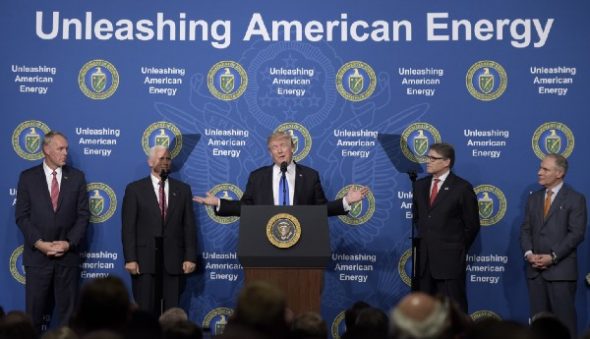As America enters a long, drawn-out and probably very ugly ‘transition’ phase, in which an autocratic, climate-denying (in the classic, ‘CO2 is plant food’ way) President scrambles to cause as much damage as possible on the way out, it’s worth noting the widespread celebrations that have occurred within climate and energy circles around incoming President Joe Biden’s success in the heated and uniquely intense contest.
The key architect of the Paris agreement jumped with joy, and many climate and energy groups congratulated Joe Biden and VP-elect Kamala Harris. It is certainly a moment to celebrate: Donald Trump has been a firehose of pure destruction for four years, razing climate, environmental and energy policies as much his administration possibly could, and a Biden presidency will be a massive shift in the right direction.
However, this shift is no guarantee of sufficient change at the pace that’s needed to ensure global temperatures remain below 1.5C in the near future. America needs to undergo a collection of gargantuan transformations in power, transport, buildings, industry and agriculture. The path to net zero is steep but far from impossible, and with a well-managed four years, Biden’s administration could kick off this process in a way that makes it enduring and resistant to wrecking from future administrations.
The hope is that Biden-Harris will be able to implement policies to put the US on a trajectory for net-zero emissions in 2050 (only CO₂ shown here).
This is ambitious, the more so given there are new Presidential elections every 4 years (vertical red lines).
Time to start… pic.twitter.com/2UYv05mQ5E
— Glen Peters (@Peters_Glen) November 9, 2020
‘Far from impossible’ doesn’t really mean ‘easy’, though. Even the power sector, the easiest of the many sectors that will need rapid action, faces an increasing challenge: how to deal with the curse of gas.
Figuring out the pathway for new clean energy growth
As I wrote previously on RenewEconomy, the growth of renewables in the US has been very significant – but nowhere near as significant as the growth of fossil gas. The fuel was strongly advocated for by Obama-era Energy Secretary Ernest Moniz, who is rumoured to be a favourite for the same role in the Biden administration. In 2019, he told EnergyWire news that “The idea we’re going to have by 2050 … a 100 percent renewable system is not realistic, straightforwardly, certainly at a reasonable cost”, and that fossil gas will remain in the system because “as more and more variable resources are brought into the electricity system, the more you are going to need natural gas for the balancing of that system”. This attitude – that the only way to reduce fossil fuel usage is to lock in more fossil fuel usage – is reflect clearly within the change in power generation the US:
 The ‘gas as a transition fuel’ era is well and truly over. Even the International Energy Agency acknowledges that coal-to-renewables and gas-to-renewables switching are the main game, with the vast majority of balancing coming from new interconnection, batteries, demand response, geographic diversity of renewables and technological diversity of renewables. The cost of renewables in the US keeps declining too, with a new data compilation from the Lawrence Berkeley National Laboratory Electricity Markets and Policy group showing plummeting PPAs for large scale solar.
The ‘gas as a transition fuel’ era is well and truly over. Even the International Energy Agency acknowledges that coal-to-renewables and gas-to-renewables switching are the main game, with the vast majority of balancing coming from new interconnection, batteries, demand response, geographic diversity of renewables and technological diversity of renewables. The cost of renewables in the US keeps declining too, with a new data compilation from the Lawrence Berkeley National Laboratory Electricity Markets and Policy group showing plummeting PPAs for large scale solar.
Even in high-solar markets like California, in which the ‘market value’ of solar declines as crowding occurs, PPA costs falling have balanced this out and preserved the technology’s ‘net value’. At the end of 2019, there is a sum of nearly 370 gigawatts of solar (a third of which is paired with storage) and just over 200 gigawatts of wind queued for interconnection into the US’ various grids. The same data for gas shows a decreasing queue, suggesting at least the high-growth days for new gas in America are coming to an end:
Also out yesterday is the US Energy Information Administration’s new ‘Short term Energy Outlook’. The EIA “forecasts that renewable energy will be the fastest-growing source of electricity generation in 2020”, and that the power sector will “add 23.2 gigawatts (GW) of new wind capacity in 2020 and 7.9 GW of new capacity in 2021. Expected utility-scale solar capacity rises by 12.8 GW in 2020 and by 13.0 GW in 2021”. Good, right? Except, they also expect that “the share of U.S. electric power sector generation from natural gas-fired power plants will increase from 37% in 2019 to 39% this year”
This mix of good renewable numbers paired with worrying gas numbers is a common theme in US electricity news. The interconnection queue data tells us that there will still be new gas-fired power stations built into the early 2020s, but of course none should be built at all. America’s pathway to net zero by 2050 must involve a very rapid fall in the burning of gas, alongside very significant increases in the output of zero carbon sources like wind and solar. Starting from right now, gas in the US across all sectors needs to plummet, and power is one of the biggest of these uses. In fact, BP’s 2020 Energy Outlook shows that gas is the only fossil fuel that will continue to grow under ‘business as usual’, in the US, and that the net zero scenario demands a very, very rapid fall:
 Renewables are becoming a powerful force in the US, but the rate of this transition matters. Biden is going to have to grapple with a power sector that is awash in gas that is explicitly not needed when it comes to decarbonisation – in fact it works actively against climate goals. This is before we get into transport, buildings and industry in the US, all areas in which both the oil and gas sectors see plenty of value in delay. The core oil and gas lobby group in the US isn’t bothered – they’re obviously happy to begin work in ensuring that America ends up on ‘business as usual’ rather than ‘net zero’.
Renewables are becoming a powerful force in the US, but the rate of this transition matters. Biden is going to have to grapple with a power sector that is awash in gas that is explicitly not needed when it comes to decarbonisation – in fact it works actively against climate goals. This is before we get into transport, buildings and industry in the US, all areas in which both the oil and gas sectors see plenty of value in delay. The core oil and gas lobby group in the US isn’t bothered – they’re obviously happy to begin work in ensuring that America ends up on ‘business as usual’ rather than ‘net zero’.
If Biden can wrest free of the Obama-era gas curse, it’s going to be a massive and unprecedented win for climate. When we get to that point, we can really begin the celebrations.












